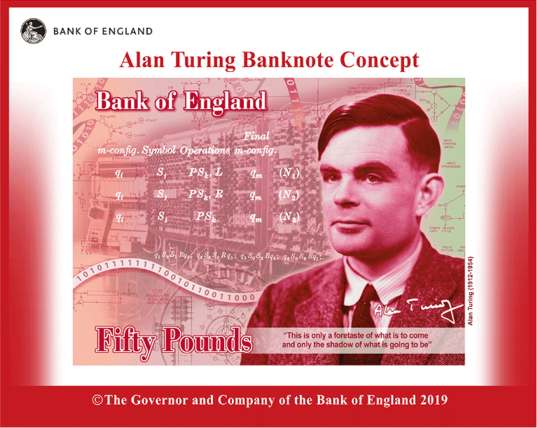| Alan Turing On £50 Note |
| Written by Sue Gee |
| Sunday, 21 July 2019 |
|
The next £50 bank note, the highest denomination issued by the Bank of England, honors Alan Turing. This news prompted The Times to write a new obituary for "this enigmatic genius". Having announced last year that the £50, which is expected to enter circulation by the end of 2021, would commemorate the field of science, the Bank of England received a total of 227,299 nominations, covering 989 eligible characters. This was reduced to a shortlist of 12 options, from which the Governor, Mark Carney made the final selection. In making the announcement at the Manchester Museum of Science and Industry, Carney stated: "Alan Turing was an outstanding mathematician whose work has had an enormous impact on how we live today. As the father of computer science and artificial intelligence, as well as war hero, Alan Turing's contributions were far-ranging and path-breaking. Turing is a giant on whose shoulders so many now stand.” The Bank of England press release also notes: Alan Turing provided the theoretical underpinnings for the modern computer. While best known for his work devising code-breaking machines during WWII, Turing played a pivotal role in the development of early computers first at the National Physical Laboratory and later at the University of Manchester. He set the foundations for work on artificial intelligence by considering the question of whether machines could think. Turing was homosexual and was posthumously pardoned by the Queen having been convicted of gross indecency for his relationship with a man. His legacy continues to have an impact on both science and society today. The design of the note incorporates many different aspects of his pioneering work and features:
The quote on the bank note reads: “This is only a foretaste of what is to come, and only the shadow of what is going to be.” These words of Alan Turing come from an article in The Times of 11 June 1949 with the title The Mechanical Brain, which reports how the Manchester Mark 1 had been used by Turing and Max Newman to compute Mersenne Primes. But Turing didn't expect the computer to be confined to performing repetitive calculations, seeing it instead as a thinking machine and the full quote continues: "We have to have some experience with the machine before we really know its capabilities. It may take years before we settle down to the new possibilities, but I do not see why it should not enter any one of the fields normally covered by the human intellect, and eventually compete on equal terms.” When Alan Turing died in 1954 his original Times obituary was short and "terse" according to the extended one published in response to his appearance on the bank note. This was partly because the very existence of Bletchley Park and the code breaking work done there was not officially acknowledged until 1974, secrecy which led to him being under appreciated in his lifetime. The new one makes up for its omissions - including discussing his homosexuality and the criminal conviction for which he was officially pardoned in 2013. When Alan Turing was featured in a postage stamp in 2012, it was the Bombe, referring to his code breaking work that was depicted. Now the £50 includes his portrait and makes reference to many aspects of his genius.
More InformationAlan Turing to be the face of new £50 note Alan Turing obituary July 20, 2019 Related ArticlesCommemorative Stamp for Alan Turing Cumberbatch As Turing - Trailers Released Turing and His Times To be informed about new articles on I Programmer, sign up for our weekly newsletter, subscribe to the RSS feed and follow us on Twitter, Facebook or Linkedin.
Comments
or email your comment to: comments@i-programmer.info |
| Last Updated ( Monday, 29 January 2024 ) |




